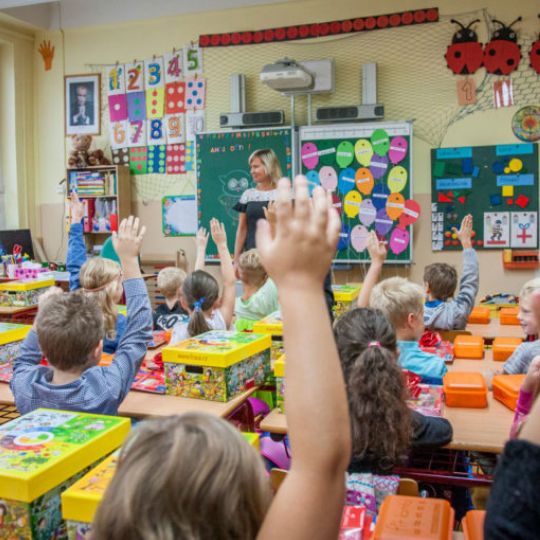
Elementary school
School attendance in the Czech Republic is compulsory from the age of 6 to 15. Most children attend state schools, but there are also newly established private and church schools. Education at state schools up to 18 or 19 is free of charge but students at secondary schools have to pay for their textbooks. Private and church schools charge school fees. All schools are coeducational. Children in our school system do not wear uniforms. Handicapped children are educated separately.
he school year starts on 1st September and ends on 30th JuneT of the following year. The school year is divided into two terms (September-January, February-June). A school day is different at different types of schools. The average number of lessons at a secondary school is around thirty a week, primary schools have fewer lessons, while specialised schools often have more. Classes begin between 8 and 8.15 and there are from 4 to 6 lessons in a row, followed by a lunch break, usually 45 minutes long, which is one period, and then afternoon classes. Afternoon classes end between 4 and 5 at the latest. Breaks between the lessons last from 5 to 15 minutes.
How does it look in the typicall elementary public school?
School buildings in our country look very similar, only their size differs depending on the number of pupils or students attending them. They are usually large buildings with a few floors, often with a sportsground attached. ln the basement or on the ground floor there are cloakrooms with students' lockers, a boiler room, a workshop, a school canteen, sometimes also a fitness centre, a snackbar, a caretaker’s flat or a gymnasium.
On the other floors there are usually long hallways with many doors leading to classrooms, teachers' offices, laboratories, a common room, the head's and deputy head's offices, the administrative office, a school library, a computer room and toilets. The hallways and staircases are decorated with pictures, flowers and there are also notice-boards, some cabinets and glasscases.
All classrooms in the Czech Republic are almost the same. There are large windows opposite the door, many of school desks and chairs with two aisles in between, a blackboard and a shelf with coloured and white chalk, a sponge and a cloth on the front wall, a teacher’s desk, a bookcase, a notice board, a few pictures and a portrait of the president, a wash-basin, a mirror, a thermometer and a waste-paper basket.
Subjects which need special equipment or aids are taught in special classrooms such as a chemistry, biology or physics laboratory, a music and an art room or a gymnasium. For teaching foreign languages a language lab is specially equipped with various audio-visual aids, such as maps, a tape or cassette recorder, a slide or overhead projector, a screen and a video. Some schools also have an assembly hall.
What is a lesson in a Czech school like?
After the bell, when the teacher enters the room, the pupils or students stand up to greet him. He makes an entry in the class register, marks absent students and then he starts the lesson with revision of the previous lesson. He examines the pupils individually by asking them to come to the blackboard, they are asked to reckon, do an exercise, explain a problem, respond to teacher’s questions or sometimes the whole class takes a written test.
The performance of the students who excel is usually perfect, they are fluent and creative. Sometimes the performance is rather disappointing both for the teacher and the student alike. The reasons differ from not paying attention in class, not doing homework regularly and copying it in the break before the lesson, relying on one's pretty face, cutting classes and not working consistently and systematically to spoiling one's performance due to nervousness.
The results range from excellent, very good, good, and satisfactory to failure. After examination the teacher explains a new subject matter and practises it with exercises. Before the end of the lesson he sums up the topic and sets assignments for the next lesson.
The teachers are supposed to follow the curriculum but they are free to choose textbooks for their students. Some students stay at school after school hours and take part in after-school activities such as singing in the choir, drama club, arts club, reciting club or games.)
How do I enroll my child to the public elementary school?
The tutorial you can find here.